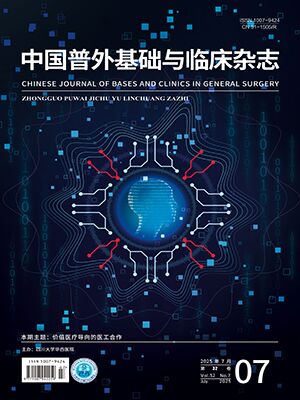ObjectiveTo explore the values of CA19-9, CA242, CEA, and CA125 single or combined detection on clinical diagnosis and prognosis for patients with pancreatic cancer. MethodsSerum tumor markers CA199, CA242, CEA, and CA125 of 63 patients with pancreatic cancer, 33 patients with cancer of bile duct, and 27 patients with benign pancreatic disease were detected, and those patients were followed up after operation. ResultsThe levels of CA19-9, CA242, CEA, and CA125 in patients with pancreatic cancer were significantly higher than those in patients with benign pancreatic disease and cancer of bile duct (P lt;0.05). The sensitivity of CA19-9 alone was the highest in the four tumor markers for the patients with pancreatic cancer 〔79.4% (50/63)〕, but the specificity (61.9%) was lower than that of CA242 (83.3%) and CEA (80.0%). The specificity of combined detection of CA199+CA242+CEA was the highest 〔93.3% (56/60)〕. The level of CA19-9 in carcinoma of body/tail of pancreas was significantly higher than that of carcinoma of pancreas head or whole pancreas (P lt;0.05). The serum levels of CA19-9 and CA242 in patients with stage Ⅳ were significantly higher than those in stage Ⅰ or Ⅱ/Ⅲ (P lt;0.05). Fifteen patients were lost to follow up, 48 patients were followed up 2-12 months with an average 6 months. The levels of CA242 and CA199 in patients with pancreatic cancer on 0.5 month and 3 months after operation were lower than those before operation (P lt;0.05). ConclusionsSingle detection of CA19-9 can improve the diagnostic sensitivity, and combined detection of tumor markers CA199+CA242+CEA can improve the diagnostic specificity. CA19-9 or CA242 is a valuable marker for evaluating treatment effects and estimating prognosis.
Citation: LI Ning,SHEN Shiqiang,LIU Jianchao.. Values of CA199, CA242, CEA, and CA125 in Diagnosis and Prognosis for Pancreatic Cancer. CHINESE JOURNAL OF BASES AND CLINICS IN GENERAL SURGERY, 2011, 18(3): 300-301. doi: Copy
Copyright © the editorial department of CHINESE JOURNAL OF BASES AND CLINICS IN GENERAL SURGERY of West China Medical Publisher. All rights reserved




